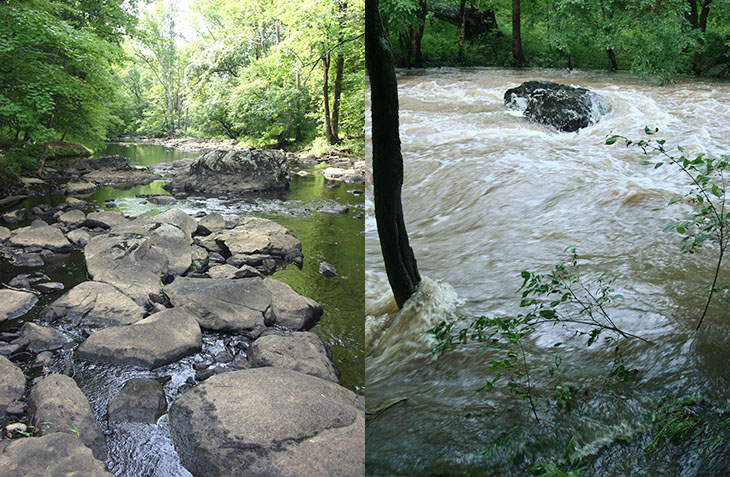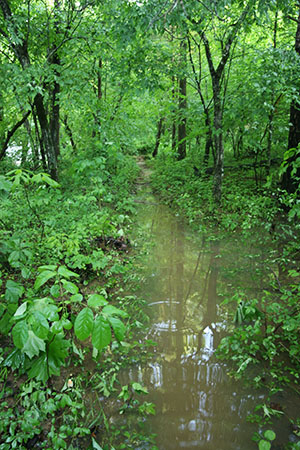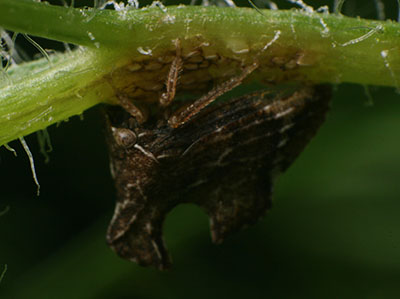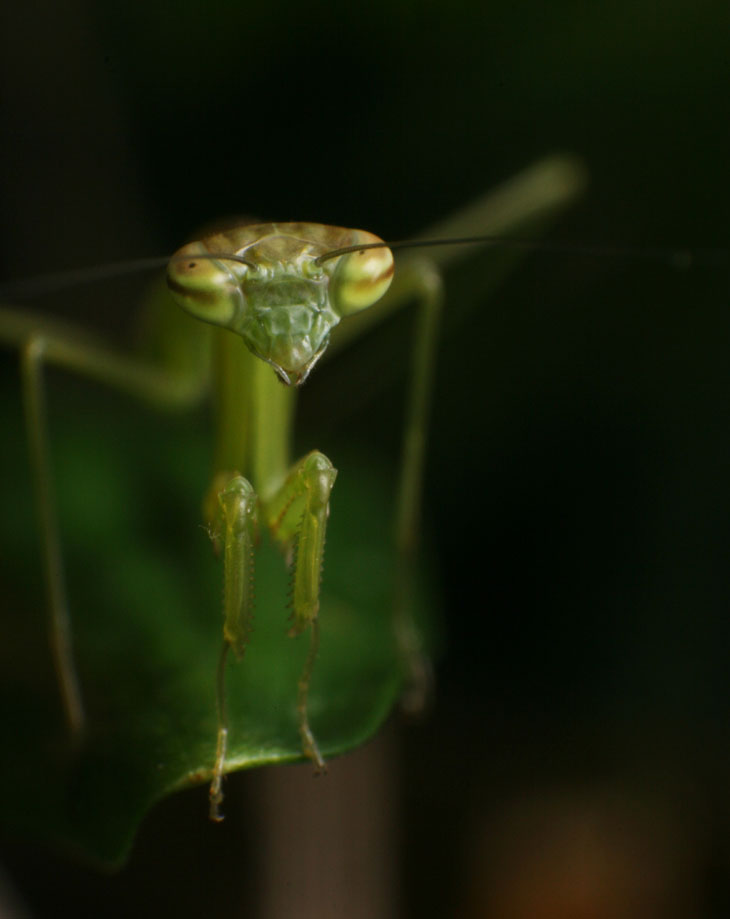I’m still here, and still largely busy – it’s going to be a lean posting month, but I’ll still try to put something up from time to time.
[“From time to time” – isn’t that a stupid phrase? Who makes these things up, and did they have any think what word good is?]
A few days back we received torrential rain, which is not to say this is any more remarkable than the rest of the country, but only as a lead-in, since it spurred me to go down to the river. I’ve seen plenty of evidence that it rises dramatically, yet never been down there to witness it firsthand, so I stopped down briefly the morning after the deluge. Below is a comparison composite image, the left side taken a few years ago but representative of typical conditions, while the right is the level Friday morning.

It’s the same boulder in the middle of both pics, except one is seen aiming downstream while the other shooting across from the small point seen in the former. I wasn’t going to go wading in the river that day.
You can see how the river is flooding the banks in the right image, and as I stood there, a largish snapping turtle appeared between the tree and I, struggling desperately to gain a foothold on the flooded bank before vanishing back into the torrent; I had barely raised the camera and didn’t even lock focus before it was gone.
 This is part of the path that winds alongside the river, only about 20 cm under water at this point so I was still able to follow it – I spend the non-winter months in waterproof sandals specifically for conditions like this, because I think it’s silly to let a little water block me from something interesting. My feet are so used to this that I rarely notice the water temperature at all, unless it gets really extreme. [An example of this was when my dad visited one winter and we went out to the Outer Banks. He snagged a favorite and expensive fishing lure on something not far offshore, while casting in Croatan Sound off Roanoke Island, and I waded in barefoot to try and retrieve it – the water temperature did not exceed 4°c (40°f.) It took two attempts and became pretty painful, turning my lower legs beet red, but I got the lure and recovered quickly. I still find the people who go swimming in freezing weather to be morons, though.]
This is part of the path that winds alongside the river, only about 20 cm under water at this point so I was still able to follow it – I spend the non-winter months in waterproof sandals specifically for conditions like this, because I think it’s silly to let a little water block me from something interesting. My feet are so used to this that I rarely notice the water temperature at all, unless it gets really extreme. [An example of this was when my dad visited one winter and we went out to the Outer Banks. He snagged a favorite and expensive fishing lure on something not far offshore, while casting in Croatan Sound off Roanoke Island, and I waded in barefoot to try and retrieve it – the water temperature did not exceed 4°c (40°f.) It took two attempts and became pretty painful, turning my lower legs beet red, but I got the lure and recovered quickly. I still find the people who go swimming in freezing weather to be morons, though.]
New, untouched silt and debris were distributed onto the path at higher elevations than this as well, indicating that the water level had been at least a half-meter higher, and probably more like a meter, sometime the previous night. It’s difficult to predict how hard this is on the local animal life; I know beavers often live in hollows in the banks, and water snakes are common, but both of these need air and can be drowned in their dens if the water level traps them within. Animals such as deer than venture into the rapids can easily be swept away, and the debris that is carried can be pretty dangerous even to animals that can handle the turbulent water.
There’s not much else going on. I haven’t been tackling any philosophical ideas recently, and I have a number of posts in draft form but nothing I feel too motivated to finish. It goes that way sometimes, and while I occasionally feel bad for not putting up new content, I also made up my mind long ago not to post for the sake of posting (whether I’m succeeding in that resolve remains to be seen, I suppose.)
Even the arthropods have been fairly scarce. The mantids dispersed quickly throughout the yard, and I occasionally spot one but they’re still shy about close contact; at their size, anything that shows detail at all is close contact, so good shots are tricky.
One exception is a variety of treehopper that has descended on the erupting dog fennel plants. I had to check just now to determine what the difference was between treehopper and leafhopper; basically, treehoppers look like thorns while leafhoppers look like buds or seeds. I also had to add both words to my computer’s dictionary so it would stop highlighting them as misspelled; it seems to think either should be two separate words, or hyphenated at least.

 This is an Entylia carinata, no apparent common name, and a significant number appeared on the plants overnight it seems. They run about 5mm in length, and have a tendency (like all ‘hoppers) to scuttle around to the back side of the stem when someone leans close, so it took quite a few tries to get a nice shot. The pic at right, in fact, is one I consider a ‘miss’ except for one thing: I’m pretty sure the discoloration of the plant stem beneath the treehopper is from the damage that they do while sucking out the sap. The amount of nutrients they extract from the sap is minimal, so they draw a lot and process it through their systems pretty quickly, excreting the rest as ‘dew’ that is often harvested by ants. No ants were taking advantage of these, however, even though the species is known as a favorite of them. I’ll keep my eyes open, since while I have a few images of ants farming leafhoppers and aphids, I’d still like some more detailed examples.
This is an Entylia carinata, no apparent common name, and a significant number appeared on the plants overnight it seems. They run about 5mm in length, and have a tendency (like all ‘hoppers) to scuttle around to the back side of the stem when someone leans close, so it took quite a few tries to get a nice shot. The pic at right, in fact, is one I consider a ‘miss’ except for one thing: I’m pretty sure the discoloration of the plant stem beneath the treehopper is from the damage that they do while sucking out the sap. The amount of nutrients they extract from the sap is minimal, so they draw a lot and process it through their systems pretty quickly, excreting the rest as ‘dew’ that is often harvested by ants. No ants were taking advantage of these, however, even though the species is known as a favorite of them. I’ll keep my eyes open, since while I have a few images of ants farming leafhoppers and aphids, I’d still like some more detailed examples.
I’ll close, despite my disparaging comments above, with a mantis image. It might seem strange, but different individual insects can display different ‘personalities,’ or to be more accurate, varying responses to the same stimulus. What this means is some of the mantids from the same hatching are quite spooky and go for cover if I make the wrong move, while at least one other seems pretty tolerant of me leaning close with the camera and flash/softbox rig. Since this one has moved to a patch of some ornamental grass next to the rosemary bush, I am confident that I’m encountering the same individual, who has now taken on a more distinctive green hue. While larger, this one is still only 20 mm in overall length, so you can imagine how small the head is. In contrast, the sibling who has moved to the dog fennel plants is far more circumspect, and hasn’t allowed any decent images at all, much less a menacing portrait of this nature.





















































